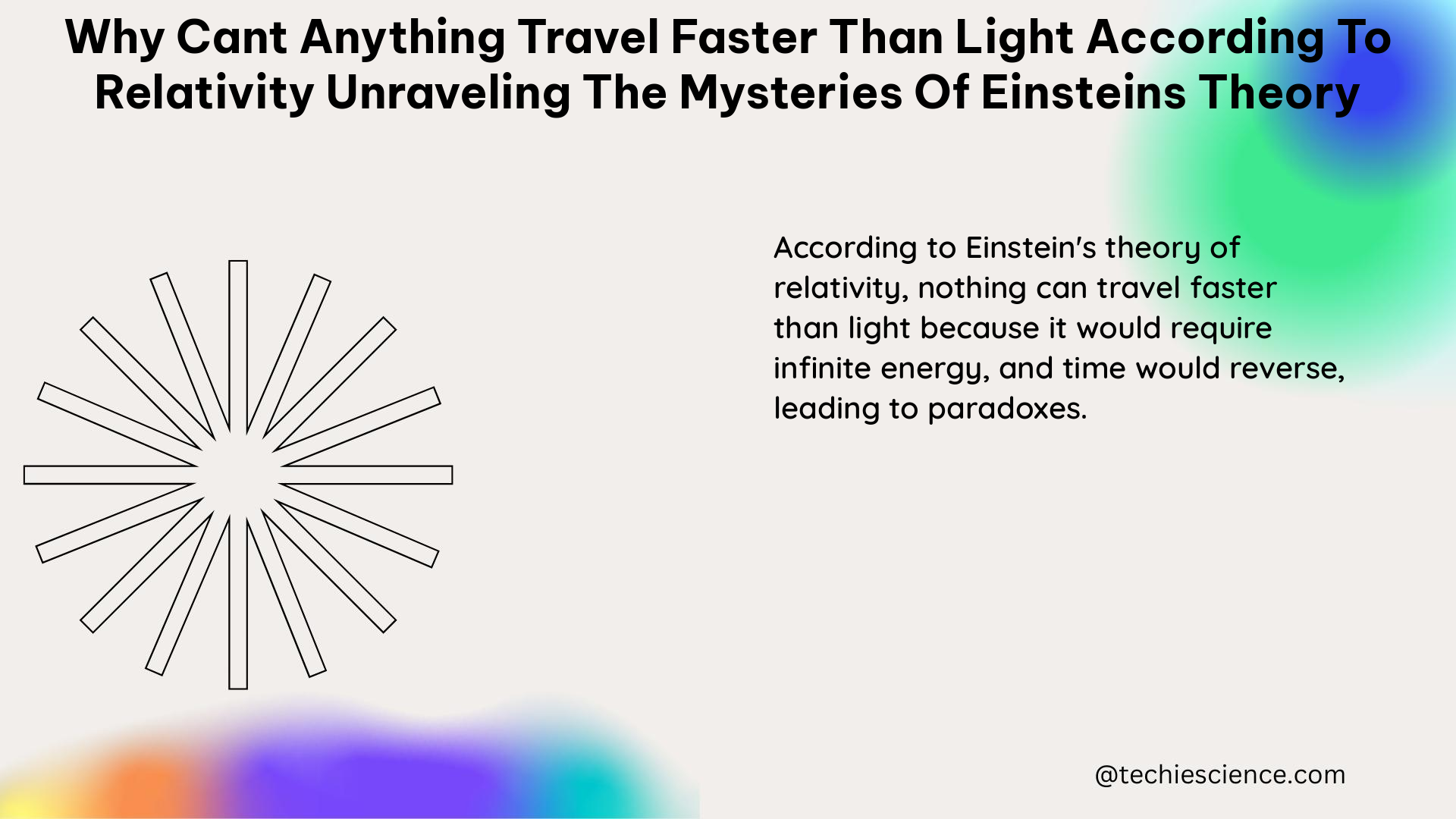The concept of nothing being able to travel faster than light is a fundamental principle of Einstein’s Theory of Relativity, specifically his Special Relativity theory. This principle is based on two postulates that form the foundation of this groundbreaking theory.
The Two Postulates of Special Relativity
-
The laws of physics are invariant in all inertial frames of reference: This means that the laws of physics, such as the laws of mechanics, electromagnetism, and thermodynamics, are the same in all reference frames that are moving at a constant velocity relative to one another.
-
The speed of light in a vacuum is the same for all observers, regardless of the motion of the light source or observer: This is the key postulate that sets the speed of light as an absolute speed limit. The speed of light in a vacuum is approximately 299,792 kilometers per second (km/s) or 186,282 miles per second (mi/s).
The Reason for the Speed Limit

The reason for this speed limit can be explained by the theory’s time dilation effect. As an object with mass approaches the speed of light, its relativistic mass increases, requiring more and more energy to continue accelerating. At the speed of light, this relativistic mass would become infinite, requiring infinite energy, which is impossible to achieve.
Relativistic Mass and Energy
According to the theory of Special Relativity, the mass of an object increases as it approaches the speed of light. This is known as relativistic mass, and it is described by the following equation:
$m = \frac{m_0}{\sqrt{1 – \frac{v^2}{c^2}}}$
Where:
– $m$ is the relativistic mass of the object
– $m_0$ is the rest mass of the object (the mass at zero velocity)
– $v$ is the velocity of the object
– $c$ is the speed of light in a vacuum
As the velocity of the object approaches the speed of light ($v \rightarrow c$), the denominator of the equation approaches zero, causing the relativistic mass to approach infinity. This means that the amount of energy required to accelerate the object to the speed of light would also approach infinity, which is not practically achievable.
Numerical Example
Let’s consider a hypothetical object with a mass equal to a proton (approximately 1.67 x 10^-27 kg). To accelerate this object to 90% the speed of light would require approximately 4.5 x 10^16 joules of energy. To accelerate it to the speed of light would require infinite energy, which is not practically available.
This example illustrates the concept that as an object with mass approaches the speed of light, the amount of energy required to continue accelerating it increases dramatically, effectively making it impossible for anything with mass to reach or exceed the speed of light.
The Implications of the Speed Limit
The speed limit imposed by the speed of light has several important implications in the realm of physics and our understanding of the universe:
-
Causality and Time Travel: The speed limit prevents the possibility of information or matter traveling faster than light, which is necessary to maintain the principle of causality (the idea that the future cannot affect the past). This effectively rules out the possibility of time travel, at least in the traditional sense of traveling backward in time.
-
Relativistic Effects: The speed limit gives rise to various relativistic effects, such as time dilation, length contraction, and the equivalence of mass and energy (as described by the famous equation $E = mc^2$). These effects become significant at velocities approaching the speed of light and have been extensively verified through experiments.
-
Cosmic Speed Limit: The speed of light serves as a cosmic speed limit, limiting the rate at which information and matter can be exchanged across the universe. This has important implications for our understanding of the evolution and structure of the cosmos.
-
Particle Accelerators: The speed limit has practical implications for the design and operation of particle accelerators, which are used to study the fundamental nature of matter and energy. The challenge is to accelerate particles to ever-higher energies without exceeding the speed of light.
Conclusion
The speed limit imposed by the speed of light is a fundamental principle of Einstein’s Theory of Relativity, with far-reaching implications for our understanding of the physical world. The inability of anything with mass to reach or exceed the speed of light is a consequence of the theory’s time dilation effect and the dramatic increase in relativistic mass as an object approaches the speed of light. This speed limit has shaped our understanding of causality, relativistic effects, and the structure of the universe, and continues to be a central focus of research in modern physics.
References
- Special Relativity on Wikipedia
- HyperPhysics – Relativistic Mass
- Physics Classroom – Relativistic Mass
- Einstein’s Special Relativity and the Speed of Light
- The Speed of Light and the Limits of Special Relativity

The lambdageeks.com Core SME Team is a group of experienced subject matter experts from diverse scientific and technical fields including Physics, Chemistry, Technology,Electronics & Electrical Engineering, Automotive, Mechanical Engineering. Our team collaborates to create high-quality, well-researched articles on a wide range of science and technology topics for the lambdageeks.com website.
All Our Senior SME are having more than 7 Years of experience in the respective fields . They are either Working Industry Professionals or assocaited With different Universities. Refer Our Authors Page to get to know About our Core SMEs.